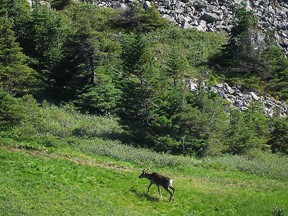Quebec’s caribou population has been in decline for several years and exploitation of the forest industry is the main cause of the crisis.

Article content
Witnesses heard by federal officials on a committee said Monday that a decree to protect caribou would be devastating for the economy of an entire region, while the chief of the Assembly of First Nations Quebec-Labrador sees this measure as necessary to ensure the survival of endangered herds.
“How can we imagine a whole population getting up in the morning without any idea of what its future might look like?” said Lise Boulianne, mayor of Sacré-Coeur.
Advertisement 2
Story continues below
Article content
In her eyes, the “development” of her community, which lies where the Saguenay and St. Lawrence rivers meet, “passes and will always pass through the forestry industry.”
At her side, Steeve St-Gelais, president of Boisaco, said that 600 jobs would be lost with Ottawa’s proposed decree.
“And this will mean the loss of more than $200 million in annual benefits in total for our community. This is inconceivable,” he said.
Quebec’s caribou population has been in decline for several years and the forestry industry is the main cause of the crisis; roads through forests destroy the habitat and promote the displacement of the caribou’s natural predators such as bears and wolves.
“There is an urgent need to act for the caribou, which is an umbrella species essential to the health of our ecosystems and the biodiversity that lives there,” said Ghislain Picard, Chief of the Assembly of First Nations Quebec-Labrador.
He stressed that his organization supports the federal government’s intention to impose a decree on Quebec to force the province to protect caribou in three distribution areas: Val-d’Or, Charlevoix and Pipmuacan.
Article content
Advertisement 3
Story continues below
Article content

In Val-d’Or and Charlevoix, the caribou live in enclosures year-round, with respectively nine and 30 individuals, while the Pipmuacan herd counts less than 300 animals.
In April, Quebec stated its intention to invest $59.5 million to launch projects to protect 13 populations of caribou in the province. But federal environment minister Steven Guilbeault expected the Legault government to present a strategy to protect all the caribou populations, as per an agreement in principle signed in August 2022 between the federal and provincial governments.
According to the agreement, the measures put in place could allow for “the attainment of 65 per cent of undisturbed habitat in each of the zones where caribou are dispersed. Despite a succession of announcements to protect the species, Quebec has not presented a strategy that would attain this objective.
“If we find ourselves in this precarious situation today, it is entirely due to the inaction of the Quebec government in this matter,” Picard said.
A consultation on Ottawa’s draft decree is underway until Sept. 15 and should lead to the final version.
The Legault government refused to participate in the consultation. It believes its own measures to protect the declining species are bearing fruit.
The province believes that with the federal decree, there will be “a loss of at least 2,000 jobs, for the projected temporary zones alone.”
With files from Stéphane Blais.
Recommended from Editorial
Advertisement 4
Story continues below
Article content
Article content


Comments